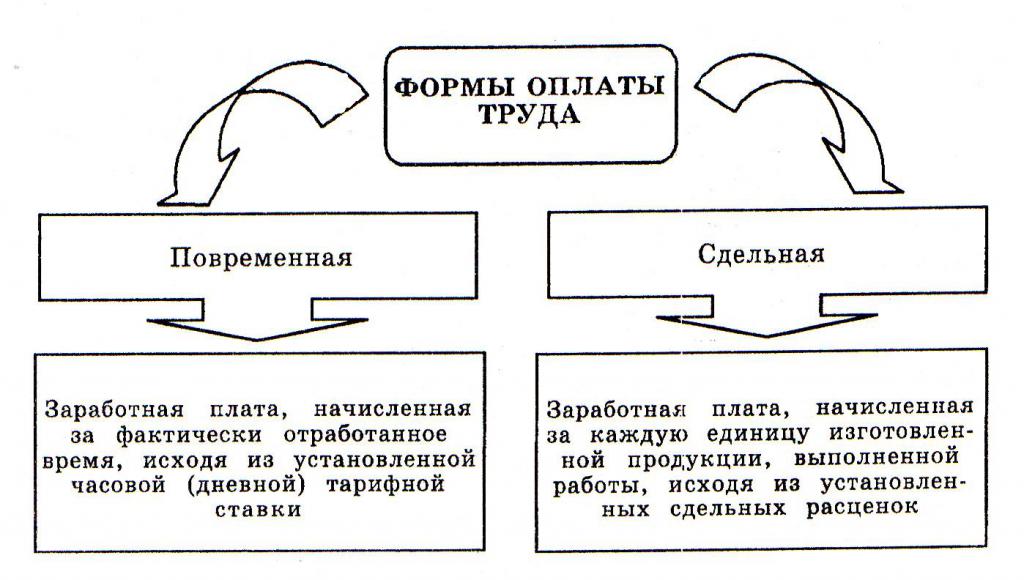The procedure for calculating wages depends on its type. For this reason, you must first determine what wages are, and then study its accrual order. So, we will begin to understand all the subtleties and concepts.
Definition

To understand what the procedure for calculating wages, you need to know how the law understands it. Salary is the remuneration for labor. The same definition is recorded in the Labor Code of our country.
Correctly calculate it and comply with the procedure for calculating wages must the employer. They accrue a certain amount of money to the employee at the established rates, salaries or rates. And also take into account the actual time worked by the employee or the volume of products manufactured by him.
But it is important to know that charging varies between state-owned enterprises and commercial organizations.
Documents for accrual in commercial organizations
In any non-state enterprise, in order to accrue wages, it is necessary to provide a whole package of documents. Namely:
- Papers that establish the size of the employee's salary and its form. For example, the staff list, the provision on labor remuneration, an employment contract, an order for employment.
- Papers that confirm compliance with production standards. For example, time sheets, work orders, books that take into account developments.
- Documents affecting the size of wages. This includes orders for encouragement, any memos.
There is a provision on remuneration. It is an official document that displays the procedure for payroll. In addition, it indicates the categories of employees, the criteria by which their work is evaluated, the type of activity, tariff rates, and the amount of bonuses.
Now we will analyze the procedure for calculating and paying salaries.
How to charge?

When the employer pays wages, he is obliged to notify the employee of the amount due to him in writing. There is no concrete sample of the latter, therefore, the settlement form is compiled in free form. This document is formed once a month, most often when the second part of the salary is accrued.
The settlement sheet, as a rule, contains:
- deduction information;
- information on the full amount payable;
- information about the parts of wages due.
If the organization has violated the rules for compiling or issuing settlement forms, it can be brought to administrative responsibility.
The important thing is that the procedure for calculating and paying salaries varies slightly. What does it mean? But here: the amount that is due to the employee, and the salary issued on hand, differ from each other.
All this happened due to changes in the legislation of January 2010. Since that time, the procedure for calculating wages and accounting has changed. Now, from all accruals, contributions are paid for medical, pension and social insurance.
According to the Labor Code of our country, wages are accrued monthly, and paid twice a month. In addition, all deadlines for payments must be displayed in the collective agreement and other documents of the organization.
You can’t agree orally on the payment of salaries only once a month or write it in some local papers. It's illegal. It is also illegal to withhold the due salary of employees. Especially often this happens during a financial crisis or internal problems of an organization. For such actions, the latter may incur administrative and financial responsibility.
If wages are delayed, then this delay should then be compensated financially. The minimum amount of compensation is three hundredth of the refinancing rate of the country's bank. That is, for each day of delay in salary this part of the main earnings will be charged. In order for compensation to be paid, no specific reason for the delay is needed; this rule applies to all reasons. Salaries should not depend on the financial situation in the company.

Salary certificate
Often a person has to take a salary certificate to prove his income. Usually she is needed to get a loan, a pension, to register at the employment center or to get a visa. She is issued for three days and the personnel department is engaged in this. Such a document confirms the position of the employee, his salary and place of work. It must be signed by the chief accountant and the head of the organization.
Gray or white salary

The procedure for calculating and registering wages is determined by the Labor Code of our country. And the salary itself is established by the labor contract and corresponds to the remuneration system of a particular employer. The labor contract includes all bonuses, bonuses and incentives, not to mention the salary and the tariff rate.
That is why when drafting the contract, it is necessary to clearly state the terms of payment. Because as a result of any financial disagreement with a "gray" salary, it will be necessary to seek the truth through the courts. Because it will require witnesses and evidence, and the labor inspectorate does not have the authority to conduct an investigation.
Payment Procedure

According to the Labor Code, salaries are required to be paid every two weeks. But at the same time, the payment dates are set by the organization itself. This means that any employment contract drawn up with one payment date is considered illegal.
If the day the payroll coincides with the holidays and weekends, then the procedure for calculating the amount changes. In such situations, the employee must receive a salary before this day. A vacation should be paid no later than three days before it begins. If the payment is delayed, then the vacation can be postponed.
When a salary is paid, the manager must provide each employee with a paper that contains all the information about the accrual. In what form will the pay slip be - the employer decides.
The Labor Code also regulates the term for payments upon termination of the employment contract. According to the law? the employee must receive the calculation on the day of dismissal. If the former employee did not work that day, then all money must be paid no later than the next day.
When disputes arise regarding the amount of paid amounts, the manager is obliged to pay such an amount that is not subject to dispute.
Wage delay
Whatever type of wage and accrual procedure may be, but it also happens that it is delayed. Sometimes the salary is delayed for fifteen days, then the employee can suspend his work, but before that he must warn the manager in writing. If work is suspended, the employee is not required to be present at the workplace. The time when work is suspended is not paid to the employee, unless the collective or labor agreement provides otherwise.
If wages are delayed through the fault of officials, these persons may be held administratively, disciplined, financially or criminally liable.
Also, the employer is obliged to pay monetary compensation in case of delay in payment of leave, salary, calculation upon dismissal. This compensation is calculated as the three hundredth part of the rate from refinancing the bank. The manager is obliged to pay compensation regardless of whether he is guilty or not of the delay.
Payroll to employees

According to the Labor Code of our country, the minimum wage cannot be lower than the cost of living, but it is established throughout the territory of our country.
The procedure for payroll by the company is also regulated by the following data:
- Type of wage system, which is adopted in the organization.
- The type of ratings and rates that the organization practices.
- The volume of production or the amount of time worked.
Over the course of a month, the employer or the accounting department (depending on the size of the organization) fills out a time sheet for each employee. It takes into account working hours. After filling these papers go to accounting. Further, according to personnel orders, salary is accrued.
But it is worth remembering that some money is kept from the salary. It:
- income tax;
- child support (if any);
- compensation for damage caused by an employee;
- the amount of loans that are provided to the employee, with interest;
- the first part of the salary for half a month;
- debt retention from an employee;
- withholding an amount that was not spent from accountable finances;
- withholding contributions from union members;
- withholding of funds that will go to the pension fund for the accumulation of pensions;
- deductions for health insurance;
- other employee-initiated retention.
According to the law, the procedure for accruing and deducting from wages is standard. The only thing that is strictly observed is the sum of all deductions from the employee’s salary. So, the total amount should not exceed twenty percent, but if, for example, child support is deducted from the employee, then fifty percent.
It is important that the manager must make deductions from each employee’s salary. This is called salary contributions and taxes. This is usually about thirty-four percent. This does not include injury insurance premiums.
Salary Types
Before you study the procedure for calculating and calculating wages, you need to figure out what types it happens. Salary is of two types:
- The main one.
- Additional.
The first is the payment that is accrued to employees for hours worked, as well as the quality of work and its quantity. The basic salary calculation procedure corresponds to piecework rates, tariff rates, salaries, bonuses for those who work on a piece or time basis, night work surcharges, overtime hours and so on.
Among other things, the main salary also has its subspecies. Additional payments include vacation allowance, grace hours for teenagers, maternity leave, dismissal benefits, and so on.
Payment is divided into time-based and piece-rate. Piece-rate payment is applied in cases when it is possible to take into account quantitative indicators of labor or to establish norms of time and output. That is, with such a payment system, an employee receives a salary only for the amount of products, work or services produced.
This rate is determined using calculations. The procedure for calculating wages to employees in this case is as follows: the tariff rate for a certain category of work is divided by the hourly production rate or multiplied by the established rate of days or hours.
The piecework salary also has subspecies:
- Direct piecework. It is established depending on the work done or the products that are produced.
- Indirectly piecework. This is more a reward for those workers who make a significant contribution to workers who are higher in category.
- Piecework premium. In addition to the total income, premiums are also included in this system. This subspecies motivates employees to work more and better.
- Piecework progressive. It is used to stabilize production or expand production to enter the global market. That is, everything that the employee will produce within the normal range will be paid to him at the rates applicable in the organization.If the employee produces products in excess of the norm, then the wage system of his labor increases according to progressive or increased indicators.
- Accordion. It is applied only to individual groups of employees in order to motivate them to faster and better work. For emergency or urgent tasks, they also pay by this system.
Time wage is the price of labor for hours worked. In this case, it is not possible to determine the quantity of the result of labor. With this type of payment, there are several tariff rates: monthly, hourly and daily.
The organization of the payroll procedure will be as follows:
- If an employee has worked out all the working days, then he will receive all the established salary.
- If an incomplete number of working days has been worked, then the salary is divided by the number of days worked and only this amount is paid.
In addition to the first two types of remuneration, we can distinguish another tariff and non-tariff type. The advantages of the tariff type in that it allows you to objectively evaluate the work of workers depends on the qualifications of employees and working conditions.
According to the non-tariff view, the salary is calculated according to the results of the work of the entire team. If this type of payroll is used for an employee, then the employee does not have a tariff rate or a fixed salary.
As a rule, managers, employees and specialists receive a salary based on their official salary.

Conclusion
Summing up, we can say that this topic is quite interesting, and most importantly - necessary. Knowledge on this topic will be useful to every person who is going to get a job. Of course, you can not read or study anything, but then it is likely that the rights of the employee will be violated, and he will not even know about it. Everything is good in moderation. And even if a person is savvy in terms of labor legislation, knowing the procedure for calculating wages and accounting for them, this does not mean that everything will go smoothly at work. After all, you need to look not only at how the leader fulfills his duties, but also that his own duties are carried out perfectly. Only in this case you don’t have to find out and prove something, then the work will bring joy.
